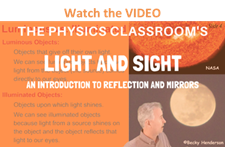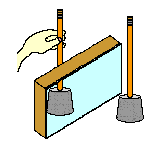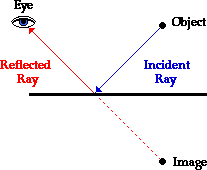Hold down the T key for 3 seconds to activate the audio accessibility mode, at which point you can click the K key to pause and resume audio. Useful for the Check Your Understanding and See Answers.
 In the first section of Lesson 1, it was stated, "without light, there would be no sight." Everything that can be seen is seen only when light from that object travels to our eyes. Whether it be a luminous object (that generates light of its own) or an illuminated object (that reflects the light that is incident upon it), you can only view the object when light from that object travels to your eye. As you look at Mary in class, you are able to see Mary because she is illuminated with light and that light reflects off of her and travels to your eye. In the process of viewing Mary, you are directing your sight along a line in the direction of Mary. If you wish to view the top of Mary's head, then you direct your sight along a line towards the top of her head. If you wish to view Mary's feet, then you direct your sight along a line towards Mary's feet. And if you wish to view the image of Mary in a mirror, then you must direct your sight along a line towards the location of Mary's image. This directing of our sight in a specific direction is sometimes referred to as the line of sight.
In the first section of Lesson 1, it was stated, "without light, there would be no sight." Everything that can be seen is seen only when light from that object travels to our eyes. Whether it be a luminous object (that generates light of its own) or an illuminated object (that reflects the light that is incident upon it), you can only view the object when light from that object travels to your eye. As you look at Mary in class, you are able to see Mary because she is illuminated with light and that light reflects off of her and travels to your eye. In the process of viewing Mary, you are directing your sight along a line in the direction of Mary. If you wish to view the top of Mary's head, then you direct your sight along a line towards the top of her head. If you wish to view Mary's feet, then you direct your sight along a line towards Mary's feet. And if you wish to view the image of Mary in a mirror, then you must direct your sight along a line towards the location of Mary's image. This directing of our sight in a specific direction is sometimes referred to as the line of sight.
It is a rather simple principle:
In order to view an object, you must sight along a line at that object; and when you do light will come from that object to your eye along the line of sight.
A luminous object emits light in a variety of directions; and an illuminated object reflects light in a variety of directions. Although this light diverges from the object in a variety of directions, your eye only sees the very small diverging cone of rays that is coming towards it. If your eye were located at a different location, then you would see a different cone of rays. Regardless of the eye location, you will still need to sight along a line in a specific direction in order to view the object.

While simple, this concept of the line of sight is also profound! This very principle of the line of sight will assist us in understanding the formation of images in both this unit (reflection) and the next unit (refraction).
 Using the Line of Sight
Using the Line of Sight
A common Physics lab involves the determination of the image location of a pencil (or some object) as formed by a plane mirror. In the process of determining the image location, the manner in which light from the object travels to your eye is investigated. First, the method of parallax is used to locate the image of the object. Two pencils are inserted into rubber stoppers; one stoppered pencil serves as the object and the other serves to assist the student in locating the image. The object pencil is placed in front of a plane mirror. Then the student sights at the image of the object pencil in the mirror. As a student sights along a line (the line of sight) at the image of the pencil, the second pencil is placed behind the mirror along the same line of sight; this is called the image pencil. When placed along the line of sight, the portion of the image pencil that extends above the mirror will be aligned with the image that is seen in the mirror. Then the eye location is repositioned to the other side of the object pencil and the process is repeated. The precise image location of the object is the location where all lines of sight intersect regardless of where the eye is located. Two important ideas are gleaned from such a lab: one pertains to how light travels from the object to the eye and one pertains to the location of the image of an object.
As you sight at the image of an object in the mirror (whether it be a stoppered pencil or any object), light travels along your line of sight towards your eye. The object is being illuminated by light in the room; a countless number of rays of light are reflecting off the object in a variety of directions. When viewing the image of the object in a plane mirror, one of these rays of light originates at the object location and first travels along a line towards the mirror (as represented by the blue ray in the diagram below). This ray of light is known as the incident ray - the light ray approaching the mirror. The incident ray intersects the mirror at the same location where your line of sight intersects the mirror. The light ray then reflects off the mirror and travels to your eye (as represented by the red ray in the diagram below); this ray of light is known as the reflected ray.

So the manner in which light travels to your eye as you view the image of an object in a mirror can be summarized as follows.
To view the image of an object in a mirror, you must sight along a line at the image. One of the many rays of light from the object will approach the mirror and reflect along your line of sight to your eye.
The second important idea that can be gleaned from this stoppered pencil lab pertains to the location of the image. Observe in the diagram above that the image is positioned directly across the mirror along a line that runs perpendicular to the mirror. The distance from the mirror to the object (known as the object distance) is equal to the distance from the mirror to the image (known as the image distance). For all plane mirrors, this equality holds true:
Object distance = Image distance
In the next part of Lesson 1, we will investigate the reflection of light in more detail. Our focus will be to identify a law that governs light reflection.
Check Your Understanding
The following diagrams depict some ideas about how light might travel from an object location to an eye location when the image of the object is viewed in a mirror. Comment on the incorrectness of the following diagrams. Discuss what makes them incorrect.